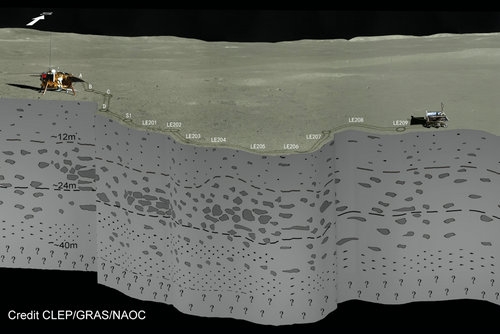[ Instrument Network Instrument R & D ] The scientific research team led by Li Chunlai and Su Yan, researchers of the National Astronomical Observatory of the Chinese Academy of Sciences, has made major discoveries in the field of deep moon exploration in China. The team used the lunar radar on the Chang'e-4 Yutu-2 lunar rover to reveal the geological stratified structure within a depth of 40 meters below the landing area on the back of the moon. Composition of stones. This research result is of great significance for understanding the impact of the impact on the moon's transformation, the scale and history of volcanic activity.

On January 3, 2019, Beijing time, the Chang'e-4 probe landed successfully at the bottom of the Von Kármán impact pit in the South Pole–Aitken basin, the oldest and largest on the back of the moon. The Feng Carmen impact crater was formed in the Pre-Jiuhai Period, with a center position of 44.45 ° S, 176.3 ° E, and a diameter of about 186 kilometers. The terrain inside the pit is relatively flat, the bottom of the pit is filled with basalt, and a considerable part of the surface of the basalt is covered by the spatters from the surrounding large impact pits, and secondary impact pits are widely distributed.
After landing on the moon, the lunar radar is just like doing a B-ultrasound to the moon, which can peek into the thickness of the lunar soil and the shallow geological structure. However, it is not a fixed-point detection, but a "mobile office".
When the lunar rover moves, the lunar radar works by transmitting and receiving antennas with a common offset point. Through the transmitting antenna, a pulsed electromagnetic wave signal is transmitted below the moon. For continuous targets, back reflection and scattering occur, forming echoes, which are received by the receiving antenna. Scientists only need to process the received echo signals to obtain a section image of an underground target. The ordinate of the obtained continuous profile image is the two-way propagation time of the electromagnetic wave, and the abscissa is the distance that the inspector moves. After the propagation speed of the electromagnetic wave is determined, the detection depth can be calculated from the two-way propagation time.
According to the obtained physical parameters and radar images, along the 106-meter path of the lunar rover, three different subsurface stratigraphic units were identified within a range of 40 meters in depth. The first unit is a fine-grained lunar soil 12 meters from the moon's surface to the ground, with a small amount of stones embedded in it. This lunar layer is formed on multiple spatters overlapping each other, which may come from the surrounding area. Finsen and von Carmen L craters. The second unit is from 12 meters to 24 meters underground. This is the area with the highest echo intensity on the radar image, indicating that there are a large number of stones in the interior, and even a gravel layer and gravel pile are formed, indicating that the sputter deposits are not only It is carpet-like spreading, and it is also accompanied by complex geological processes such as shearing, mixing, digging, and structural disturbance of secondary impact pits. The third unit is from 24 meters to 40 meters underground. The radar echo changes in light and darkness alternately. It is the product of deposition and weathering of older spatters from different periods. Radar signals below a depth of 40 meters are weak, and the high-frequency channel radar signals can no longer infer its material properties. Based on the regional geological history, it is speculated that near the Chang'e 4 landing site, the full moon sea basalt covers a depth of more than 40 meters below the moon's surface.
The moon measurement radar consists of a transmitter, an antenna, and an electronic control box (including a receiver and a controller). It includes two channels, and the antennas of the two channels are in the form of separate transceivers. The first channel transmitting antenna and the receiving antenna are installed on the lower side of the top plate at the rear of the lunar rover, and the second channel antennas are installed on the bottom side of the bottom plate of the lunar rover.
This research work obtained the first radar image of the shallow underground layer on the back of the moon, the characteristic parameters of the subsurface lunar surface, and the internal stratigraphic sequence of the sputtered material through the direct in-situ measurement of the Chang'e-4 lunar radar. For the first time, humans have unveiled the mysterious veil of the underground structure on the back of the moon, greatly improving people's understanding of the history of the moon's impact and volcanic activity, and bringing new inspiration to the study of the geological evolution of the back of the moon.
Source: National Astronomical Observatory, China Science News
Top-grade NMN Raw Material Powder,NMN Raw Material Powder for Longevity,Reliable NMN Raw Material
Shanghai CANAL Material Technology Co., Ltd , https://www.nmncanal.com
